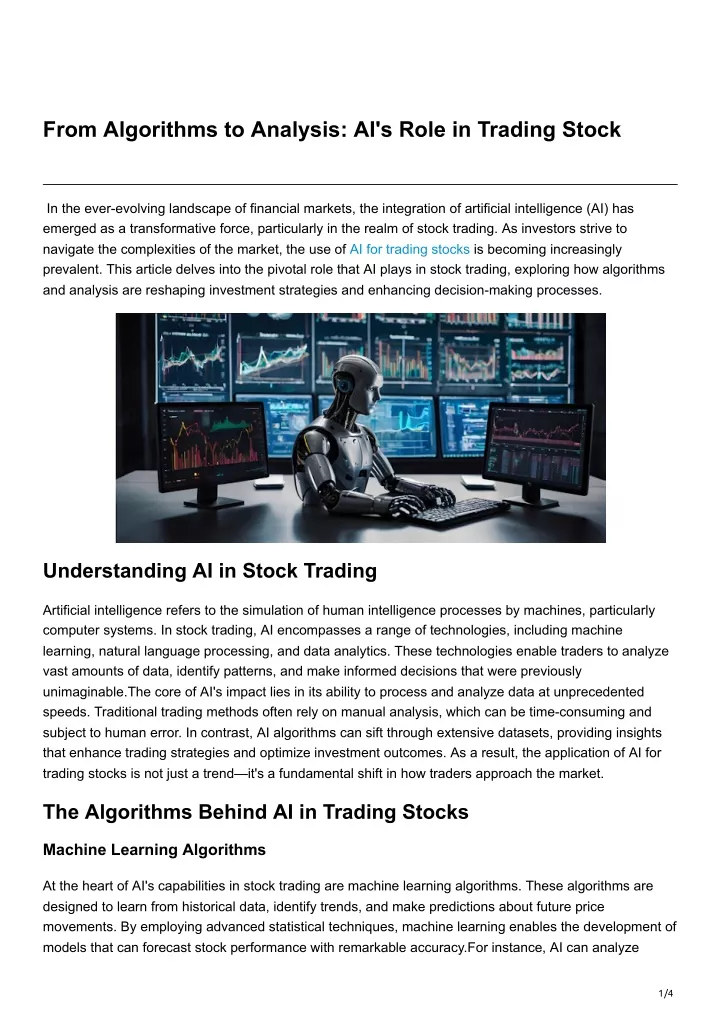20 Recommended Facts For Picking AI Stock Trading Websites
20 Recommended Facts For Picking AI Stock Trading Websites
Blog Article
Top 10 Tips When Considering The Security And Privacy Of Ai-Based Stock Predicting/Analyzing Trading Platforms
Since they are often handling sensitive financial data, or even personal information, the security and confidentiality of data is essential. A breach or misuse of data can lead to significant financial losses and reputational harm. Here are 10 tips to assess the privacy and security features of these platforms.
1. Think about Data Encryption
Secure transmission of data Verify that the platform is using secure protocols (e.g. TLS/SSL), which encrypts data between your device, as well as their servers.
Secure transport of data Verify that the sensitive information stored on a platform's servers has been encrypted with a strong encryption standard, such as AES-256.
End-to-end encryption: Find out if the platform offers end-to-end encryption to protect sensitive information or data.
2. Examine Authentication Mechanics
Two-factor verification (copyright) Make sure that the platform is compatible with copyright for an added layer of protection.
Biometric authentication - Check to see if there's biometric options available for mobile app login (e.g. finger fingerprint, facial recognition, etc.).
Password policy: Verify if the platform enforces strict password policies (e.g. minimum length or requirements for complexity).
3. Verify if you are in Compliance
Financial regulations: Make sure that the platform conforms to the applicable financial regulations (e.g. SEC, FINRA or MiFID II).
Laws on data protection: Check for compliance with privacy laws (e.g., GDPR, CCPA) If you're or trade with regions which are covered by these laws.
Audit certifications. Check that the platform you're looking at has passed third-party tests of security or has been certified.
4. Review Controls for Access to Data
Role-based Access: Make sure the platform is using role-based controls (RBAC) to restrict data access to authorized users.
Check if you have the ability to establish different levels of access for teams or users.
Activity monitoring: Make sure that the platform tracks and monitors every user's activity for any suspicious behavior.
5. Assess the vulnerability of your organization.
Regular updates - Make sure that your platform is updated with software frequently to fix any weaknesses.
Testing for penetration: Check if the platform undergoes regular penetration tests to find and correct security vulnerabilities.
Bug bounty programs: Verify whether there is a bug bounty program that is available to motivate security researchers from the outside to share weaknesses.
6. Evaluate Data Privacy Policies
Transparency: Read the privacy guidelines on the website to understand what data you provide will be used, collected and shared.
Data minimization is the method of ensuring that only the data necessary for operation are gathered by an application.
Data sharing with third parties: Check whether the platform is prepared to share your information with a third party, and If so in the process of sharing, what.
7. Secure API usage should be inspected
API security: Make sure that the API of the platform API utilizes secure authentication methods (e.g., OAuth, API keys) and secures data exchanges.
Rate limit: Make sure to check if there are rate limits within the API to stop brute force attacks or abuse.
Access logs: See whether the platform records API access and usage to allow auditing and monitoring.
8. Review Incident Response, Recovery
Incident response plan: Make sure your platform is equipped with an incident response plan for handling security breaches or data breaches.
Notification policies: Determine if users are notified promptly in the event of a security incident.
Backups of data - Make sure the platform has a strategy for disaster recovery, and that it regularly backs up data up.
9. Examine Physical Security Measures
Data center Security: Ensure servers are located in secure data centers, with physical security measures in place (e.g. monitoring, access controls).
Redundancy: Check if there are redundant platforms on the platform to ensure that data is available in case of hardware failure.
Geographic distribution: To boost resilience, verify that the data is spread across multiple geographic locations.
10. Test Privacy Controls for Users
Data deletion: Ensure that the platform lets you delete all your personal data when you decide to end your use of it.
Privacy settings: Make sure to check whether the platform has privacy settings to limit the data that is shared or visible.
Anonymization: Verify if data is anonymized for machine learning or analytics.
Bonus Tips
Feedback from users and reputation: Read user reviews and feedback in order to gauge the platform's record regarding security and privacy.
Trial period: You can use a demo or free trial to test out the security and privacy controls.
Support for customers: Ensure that the platform provides robust customer service for any security-related concerns or issues.
Check these points to determine the privacy and security level of AI trading platforms that predict stocks. In this way your financial and personal details are protected. A secure platform not only safeguards your assets but also builds confidence and trust in its products and services. Have a look at the top rated get redirected here for trading with ai for website tips including best AI stock trading bot free, AI stock trading app, ai investment app, best ai trading software, AI stock, investment ai, AI stocks, market ai, best AI stock trading bot free, ai for investing and more.
Top 10 Tips For Assessing Regulatory Compliance With Ai Stock Predicting/Analyzing Trading Platforms
When evaluating AI trading platforms, compliance with regulatory requirements is a crucial aspect. Compliance helps to ensure that the platform is operating within the legal frameworks and safeguarding the privacy of users. Here are 10 top suggestions to evaluate the regulatory compliance of these platforms.
1. Verify Registration and License
Authorities regulating the platform: Make sure that the license and registration is registered with the relevant financial regulatory authorities (e.g. SEC or FCA in the United States, ASIC or ASIC in Australia).
Check that the brokers included in the platform are licensed and regulated.
Public records: Search the website of the regulator to see if the platform has been registered or if it has any time violated the law.
2. Measure Data Privacy Compliance
GDPR: If you operate or serving users within the EU make sure the platform meets the requirements of the General Data Protection Regulation (GDPR).
CCPA: For users in California ensure conformity with the California Consumer Privacy Act (CCPA).
Data handling policies: Check the privacy policies for data on the platform to see what it says about data collection, storage, and sharing.
3. Evaluation of Anti-Money Laundering/AML Measures
AML policies - Ensure that your platform's AML policies are effective and efficient to detect and prevent money laundering.
KYC Procedures: Check if the platform has procedures in place for confirming the identities of its users.
Transaction monitoring: Verify that the platform tracks transactions in order to identify suspicious activity and alerts relevant authorities.
4. Verify the compliance of Trading Regulations
Market manipulation: Ensure that the platform is equipped with measures to stop market manipulation, such as wash trading or spoofing.
Order types. Verify that the platform complies with all regulations regarding order type (e.g. there is no stop loss hunting that is illegal).
Best execution: Make sure the platform is in line with the best execution practices, making sure that trades are executed at the highest price available.
5. Cybersecurity Assessment
Data encryption: Make sure that the platform safeguards the user's data while it is during its travel and also when it is at rest by encrypting it.
Response to incidents: Verify that the platform has a plan for incident response in place for cyber-attacks or data breaches.
Verify certifications.
6. Transparency Evaluation and Transparency Evaluation and
Fee disclosure: Make sure that the platform has clearly disclosed the fees, including hidden charges or additional costs.
Risk disclosure: See if there is a clear declaration of the risk, especially for high-risk or leveraged trading strategies.
Performance reporting: Make sure that the platform is honest and precise reports on the accuracy of its AI models.
7. Verify that you are in compliance with International Regulations
Cross-border trading: If your trading involves international markets it is important to ensure that your platform is compliant with the requirements of each regulatory region.
Tax reporting: Check whether a platform offers tools or reports for users to adhere to tax laws.
Security: Make sure whether the platform is in compliance with international sanctions, and is not able to trade with prohibited entities or countries.
8. Reviewing Audit trail trails and Record-Keeping
Transaction records: Make sure that the platform maintains precise records for purposes of regulatory and for audit.
User activity logs (logs) The logs contain information about user activity. see if the platform tracks the user's activities, including transactions and logins. Also, check if the account settings have changed.
Audit readiness: Determine if your platform can provide the necessary logs and documentation in the case of an inspection by a regulatory agency.
9. Evaluation of Compliance AI Specific Regulations
Algorithmic trading regulations: If you are using a platform which supports algorithmic trading, ensure it is compliant with the relevant regulatory frameworks like MiFID II or Reg SCI in Europe as well as the U.S.
Fairness and bias Check whether the platform modifies or monitors its AI models for ethical and fair trading.
Explainability - Ensure that the AI platform is able to provide clear and concise explanations regarding AI-driven predictions, decision-making, etc. as required by specific regulations.
Review User Feedback & Review History of Regulatory History
User feedback: Read user reviews to gauge the credibility of the platform in terms of compliance with the law.
Examine the regulatory history to see if there were any penalties or fines imposed for infractions of rules.
Third-party auditors: Find out if the platform is audited regularly by a third party to ensure it's adhering to rules and regulations.
Bonus Tips
Legal consultation: Consult an expert in the field to determine whether your website is in compliance with laws.
Trial period: Take advantage of the demo or trial version for free to evaluate the platform's conformity features and documentation.
Support for customers: Make sure whether the platform is able to provide assistance to customers who have questions or concerns related to compliance.
The following tips can assist you to assess the compliance with regulations for an AI stock-predicting/analyzing trading platform. You can pick a system that is compliant with the legal frameworks and safeguards your security. Compliance not only helps to lower legal risks, but can also increase trust in the platform. Read the most popular best AI stock prediction advice for website tips including AI stock investing, ai software stocks, AI stock investing, ai for trading stocks, stock predictor, chart ai trading, stock trading ai, investing with ai, how to use ai for copyright trading, stock predictor and more.